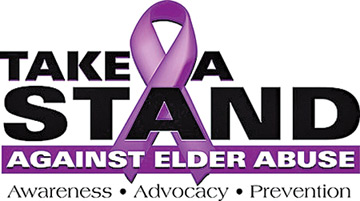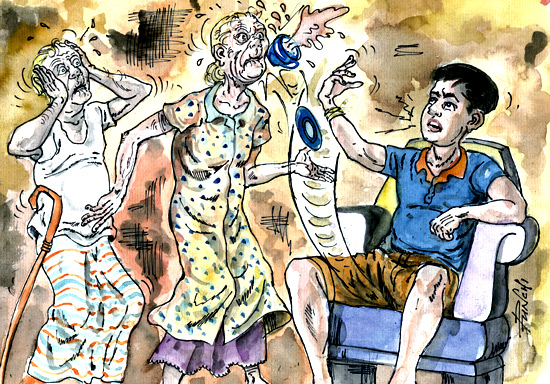Are we abusing elders?
By Carol Aloysius
Doreen, 77, was having her usual nightmare. She was walking through a
dark tunnel which seemed to be collapsing on her. In need of comfort and
assurance, she pressed the little bell on the side of her table waiting
for the night nurse to respond. There was no answer and no one came to
calm the terrified woman.
 The night attendant was comfortably snoozing in the next room. At
early dawn when she opened the door of her patient’s room she found her
huddled in a corner still shivering from those terrifying memories of
her nightmare. Her thin nightdress was drenched with sweat, and when the
nurse took her blood pressure she found it had rocketed to dangerous
levels. Her family rushed to the nearby hospital, where she received
emergency treatment to bring down her elevated blood pressure. The night attendant was comfortably snoozing in the next room. At
early dawn when she opened the door of her patient’s room she found her
huddled in a corner still shivering from those terrifying memories of
her nightmare. Her thin nightdress was drenched with sweat, and when the
nurse took her blood pressure she found it had rocketed to dangerous
levels. Her family rushed to the nearby hospital, where she received
emergency treatment to bring down her elevated blood pressure.
“ She could have had a stroke or heart attack if there had been no
speedy intervention”, the medical officer who treated her had told her
family. “Her care giver was to blame as she had neglected to care for
her patient properly”.
“Neglect is a common form of elder abuse”, said Consultant
psychiatrist Dr Indika Mudalige. “Most elders depend on their care
givers for their basic needs, including emotional support and
reassurance when they feel afraid or are lonely. Failure to do that by a
care giver is tantamount to abuse”.
Trust
Elder abuse is any form of mistreatment of elderly people by persons
they trust. The World Health Organisation defines Elder abuse as, “A
single or repeated act or lack of appropriate action, occurring within
any relationship where there is an expectation of trust, which causes
harm or distress to an older person”.
Such acts of abuse are increasing in our country and elsewhere where
elderly populations threaten to overtake the young. If the symptoms of
abuse elders are not recognised in time, the consequences could be dire,
the WHO warns.
Take the case of Sandalakshmi 61. Her erratic behaviour, neglect of
her outward appearance, inability to manage even the smallest daily
chores, her finances and loss of appetite were hall marks of a woman
with a psychological disorder.
 That her older sister was not behaving normally should have drawn the
attention of her younger sister who lived with her. But the younger
woman was too engrossed with the household chores and it was only when
Sandalakshmi stopped talking and eating and remained in bed all day,
that she decided to seek psychiatric help. That her older sister was not behaving normally should have drawn the
attention of her younger sister who lived with her. But the younger
woman was too engrossed with the household chores and it was only when
Sandalakshmi stopped talking and eating and remained in bed all day,
that she decided to seek psychiatric help.
“Most people think that elder abuse is limited to physical abuse. But
it goes beyond battering or physical harm to include sexual abuse,
emotional and psychological abuse, financial or material exploitation,
abandonment, neglect and self neglect. In the case of this lady, it was
a case of neglect by the carer and self neglect by the patient”, Dr
Mudalige explained.
In most instances self neglect is easy to detect, since outward signs
include: Rashes, sores, lice, inadequate clothing, malnourishment,
dehydration, or an untreated medical condition. “Being indifferent to
those signs or showing anger towards these people who need assistance,
can lead to self harm or worse and seriously erode the health of the
patient”, he added.
Poverty
Enforced poverty and being abandoned by one’s family is another form
of elder abuse the WHO points out. As an example let’s consider the case
of Letchimi 66 and her husband Kanan 73 who live in one of the most
congested parts of Kotahena teeming with shanties, dogs, and predators
of all ages prowling around waiting for an easy prey.
“This has been our home for the past seven years when our heartless
children forced us out of the house we had built with hard earned money
at Dematagoda. Today, we live in a shack covered with polythene sheets,
and have to beg for food”, Kanan lamented. Abandoned, malnourished from
want of a proper meal and exposed to the harsh elements, they along with
other elders keep adding to the swelling figures of lonely abandoned
persons abused by their own children.
Explosion
While beggars are conspicuously absent on our streets these days,
consider the large numbers of underprivileged elderly persons who we see
on our streets every day. Many are blind, lame, crippled by severe
arthritis, their backs bent by osteoporosis. How many of us bother to
stop and ask if they need our help, whether financially or by simply
offering them a nutritious meal and helping them to cross a busy street?
That the world is witnessing an explosion of grey populations
everywhere is a disturbing truth that has to be faced. As in Sri Lanka,
people now live longer due to improved health strategies that have
helped to increase their life span by leaps and bounds. But while
longevity has its advantages, it also poses challenges to health
authorities.
Take our own country. Due to the dearth of nursing homes and elders
institutions to cater to this growing population, and changes in life
styles, health authorities and those in charge of elders’ welfare are
worried that many elders could be pushed onto the streets and to survive
may even have to beg, steal or even act as drug carriers, which is
reportedly the case. Apart from these anti social activities, they are
also concerned that such elders could be open to abuse- physical, mental
and sexual that scar them mentally and psychologically for life.
How common is elders abuse?
Globally, rough estimates state that between 4-6 percent of older
populations, have suffered some form of abuse in their life time. But
the WHO says the actual figures of neglect and abuse are much higher in
the case of older persons because many of the victims are ashamed to
reveal the true situation they are in. “On the other hand, diagnosis of
elder abuse can also be difficult and some of the presentations may not
be typical”, Dr Mudalige argued. “Sometimes the elderly don’t want the
help, they may fear being institutionalised, or they feel able to care
for themselves and don’t want someone else involved in their care. As a
result, neglect can set in despite the good intentions of family
and friends. What doctors may see is a dishevelled elder who would not
be responding to therapies, because he may not able to follow the
instructions due to psycho social issues and so the disease progresses,
despite doctors best efforts”.
Research has shown that elders most vulnerable to abuse include the
following:
* Those living in shared rooms with others leaving room for
more chances for conflict and tension.
* People with dementia, and patients with aggressive behaviours, also
risk abuse due to the stress put on the carers.
• People living alone, isolated from friends and family.
* Those with a history of mental illness and alcohol misuse
Physical impairment of the old person diminishes the person’s ability
to defend him or herself.
Forms
As in the case of children and women, abuse of elders take many
forms.
“Dr Mudalige categorises elderly abuse into five basic types:
physical, sexual, emotional or psychological, financial, and neglect.
He says studies have revealed that more than half of the cases
reported involve some kind of neglect, whereas one in seven
cases involve physical abuse. Non accidental use of physical force
results in bodily injury, pain or impairment. It includes assault,
battery, and inappropriate restraint. Physical abuse may be acts of
violence such as pushing, hitting or punching, or force feeding or
improper use of restraints or medication.
Each form of abuse leaves behind a horrific outcome.
For example in Physical Abuse, the outward signs are: Cuts,
lacerations, puncture wounds, bruises, welts, discolouration, burns
and unexplained injury.
Sexual abuse which includes forced sexual contact or sexual contact
with an individual who is incapable of exercising consent because of
physical or mental impairments, leaves behind lasting mental scars.
Psychological or emotional abuse involves frightening,
humiliating, intimidating, infantilising, threatening or isolating an
older person.
Speaking from his own experience in dealing with such patients, he
said, “Hesitation to talk openly; implausible stories; confusion or
disorientation. Anger, fear, withdrawal, depression, denial, agitation,
are all symptoms of this kind of abuse.”
Financial or material abuse of an elder involves theft, fraud,
unfulfilled promises of lifetime care by either a family member or a
care giver, in exchange for assets, and limitation on the older person’s
access to his or her own assets.
Sri Lanka
Elders Abuse become a topic of interest and concern in the 1980s,
when it was cited for the first time in 1975 in The British Medical
Journal , as “granny battering”. Research and dialogue on these issues
have now resulted in legislative changes globally, that trying to
protect the vulnerable groups.
Given the steep rise in our elderly population and their
vulnerability to abuse, the time is ripe for Sri Lanka to change its
current laid-back approach to elder abuse. Due to this growing trend,
the Government of Sri Lanka passed the Protection of the Rights of
Elders Act, No 9 of 2000, which established a National Council for
Elders whose principal function is the promotion and protection of
welfare and rights of elders and to assist elders to live with self
respect, independence and dignity. In terms of this Act, children shall
not neglect their parents wilfully and and were responsible for the
looking after the needs of parents.
Are these interventions sufficient, or do we need further strategies
to meet future challenges?
Dr Mudalige said, “Passing an Act and establishing a National Council
for Elders are to be commended. But we need wider involvement of
professionals and ministries to come together and adopt a
multidisciplinary approach to fill the gaps in our legislation regarding
elders abuse, such as those involving physical, sexual and psychological
abuse. We need more Elders Homes to prevent them from being forced onto
the streets, trained nursing care for those who have been abused, and
more counsellors and psychiatrists since many elders are depressed and
mentally ill due to various factors”.
Clearly then the future of our elders lie in the hands of our nation
as a whole.
Are we ready to take up this challenge? |

